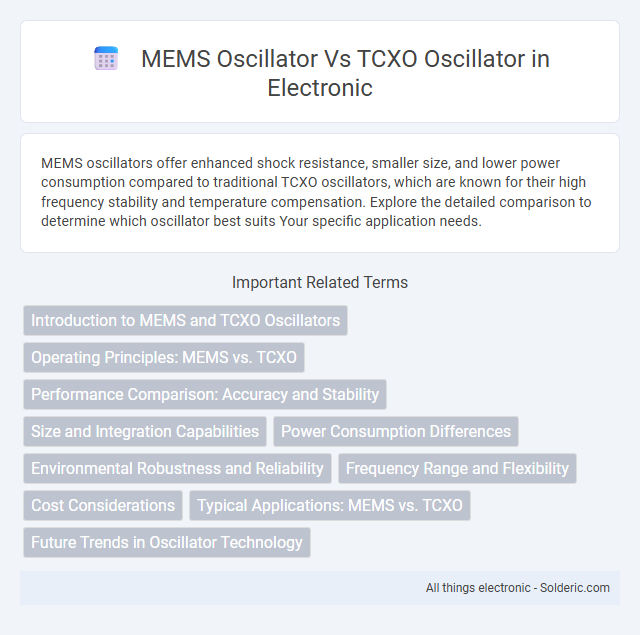MEMS oscillators offer enhanced shock resistance, smaller size, and lower power consumption compared to traditional TCXO oscillators, which are known for their high frequency stability and temperature compensation. Explore the detailed comparison to determine which oscillator best suits Your specific application needs.
Comparison Table
| Feature | MEMS Oscillator | TCXO Oscillator |
|---|---|---|
| Technology | Micro-Electro-Mechanical Systems | Temperature Compensated Crystal |
| Frequency Stability | +-10 to +-50 ppb | +-0.5 to +-5 ppb |
| Temperature Range | -40degC to +85degC (typical) | -40degC to +85degC (typical) |
| Size | Smaller size, compact chip-scale | Larger than MEMS, traditional package |
| Power Consumption | Lower power consumption | Higher power consumption |
| Shock and Vibration Resistance | High resilience | Moderate resilience |
| Cost | Higher cost due to advanced manufacturing | Lower cost, mature technology |
| Applications | Mobile devices, IoT, automotive sensors | Telecom, GPS, instrumentation |
Introduction to MEMS and TCXO Oscillators
MEMS oscillators utilize microelectromechanical systems technology to generate precise frequency signals with high stability and resistance to shock and vibration. TCXO oscillators, or temperature-compensated crystal oscillators, rely on quartz crystals with built-in temperature compensation mechanisms to maintain frequency accuracy across varying temperatures. Your choice between MEMS and TCXO depends on application requirements for size, energy efficiency, and environmental stability.
Operating Principles: MEMS vs. TCXO
MEMS oscillators utilize microelectromechanical systems to generate stable frequencies through vibrating mechanical structures, offering resistance to shock and vibration. TCXO oscillators rely on quartz crystals with integrated temperature compensation circuits to maintain frequency accuracy despite temperature variations. MEMS provides enhanced durability and integration potential, while TCXO delivers high precision frequency stability through classic crystal resonance.
Performance Comparison: Accuracy and Stability
MEMS oscillators offer superior resistance to shock, vibration, and temperature variations, resulting in enhanced long-term stability compared to traditional TCXO oscillators. TCXO oscillators typically provide higher initial frequency accuracy but can drift more significantly under environmental stress, impacting timing precision. Your choice depends on whether you prioritize robustness and stability in harsh conditions or slightly better initial accuracy for controlled environments.
Size and Integration Capabilities
MEMS oscillators offer significantly smaller size and better integration capabilities compared to TCXO oscillators, making them ideal for compact and portable electronic devices. Their micro-scale manufacturing allows for seamless integration with silicon-based circuits, reducing overall footprint and enhancing system performance. TCXO oscillators, while larger, provide stable frequency outputs but lack the miniaturization and integration advantages inherent to MEMS technology.
Power Consumption Differences
MEMS oscillators typically consume significantly less power than TCXO oscillators, making them ideal for battery-powered and portable applications. TCXO oscillators require a continuous heater to maintain temperature stability, which increases their power consumption. MEMS technology eliminates the need for a heater by utilizing microelectromechanical structures, resulting in reduced energy usage and longer device lifespan.
Environmental Robustness and Reliability
MEMS oscillators offer superior environmental robustness and reliability compared to TCXO oscillators due to their solid-state design, which makes them less susceptible to shock, vibration, and temperature variations. TCXO oscillators can experience frequency drift under extreme conditions, while MEMS devices maintain stable performance across a wider temperature range and harsh environments. Choosing a MEMS oscillator ensures enhanced durability and consistent timing accuracy for your applications in challenging conditions.
Frequency Range and Flexibility
MEMS oscillators typically operate within a frequency range of 1 MHz to 200 MHz, offering greater flexibility due to their programmability and smaller form factor, making them suitable for diverse applications. TCXO oscillators usually cover frequencies from 10 MHz to 125 MHz, providing stabilized frequencies with temperature compensation but limited tuning options compared to MEMS. The flexibility of MEMS oscillators allows dynamic frequency adjustments, while TCXO oscillators excel in providing consistent frequency stability across temperature variations.
Cost Considerations
MEMS oscillators generally offer lower production costs compared to TCXO oscillators due to their smaller size and compatibility with standard semiconductor manufacturing processes. TCXO oscillators, while more expensive, provide superior frequency stability and temperature compensation suited for precision applications. Cost efficiency in MEMS oscillators makes them ideal for high-volume consumer electronics where budget constraints are critical.
Typical Applications: MEMS vs. TCXO
MEMS oscillators excel in applications requiring compact size, low power consumption, and high vibration resistance, such as wearable devices, IoT sensors, and mobile communications. TCXO oscillators are preferred for precision frequency stability in telecommunications, GPS systems, and high-performance networking equipment due to their superior temperature compensation. Choosing between MEMS and TCXO depends on your application's tolerance for size, power, and frequency accuracy needs.
Future Trends in Oscillator Technology
MEMS oscillators are rapidly advancing with enhanced temperature stability, low power consumption, and miniaturized form factor, positioning them as the future standard for precision timing in IoT, automotive, and mobile devices. TCXO oscillators, while traditionally favored for their high frequency stability and accuracy, face limitations in scalability and integration compared to MEMS technology. Your choice will increasingly favor MEMS oscillators as they dominate future trends driven by demand for robust, low-cost, and highly reliable timing solutions across emerging applications.
MEMS oscillator vs TCXO oscillator Infographic

 solderic.com
solderic.com